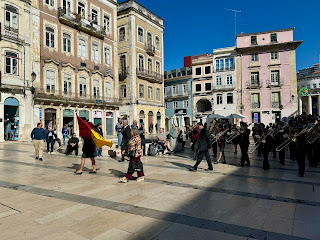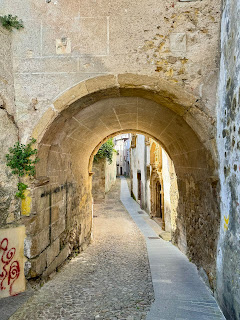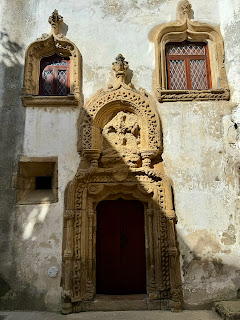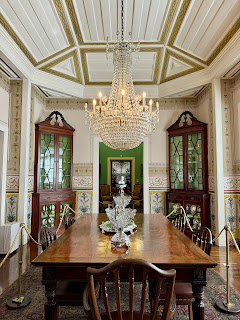Today is the Dia da Liberdade, and the fiftieth anniversary of 25 de Abril. We have tickets for the train home early this afternoon, so have time this morning to see how Coimbra does things. The locals in the shops and restaurants report that there is to be a parade down the Rua Visconde da Luz to the Praça Oito de Maio.
Returning to the Praça, we don't have to wait long for the marching bands to begin playing. The drums echo from the Rua, maybe from the direction of the Praça do Comércio. Soon the first band appears in front of the Igreja de Santa Cruz and stomps up the ramp to the terrace of the Câmara Municipal.
As we hoped when we planned this 'escape', there are no crazy crowds. Maybe three or four bands go by, but otherwise the Praça looks much as it does on every other day – pleasant and enjoyable.
For us, the one area of Coimbra's Alta that remains unexplored is the 'north side', we head there now. We first find the Museu da Santa Casa da Misericórdia (seventeenth century), which has the Baroque pediment that we see from below.
The traveller goes out in pouring rain. He goes to visit the Casa do Navio, then returns to Alta, and can’t visit Coimbra without looking at the Casa de Sub-Ripas, so worm-eaten, sadly for us and for it, and the Torre de Anto, where António Nobre lived out his final and true Castilian vocation. The traveller doesn’t know whether anyone lives there today. He could have checked it out, but it didn’t occur to him. (José Saramago, “Journey to Portugal,” 1990; trans Hopkinson-Caistor, 2000)
We seek out the Torre de Anto and the Casa de Sub-Ripas (sixteenth century), two vertical structures on the edge of the west-facing slope connected by an elevated stone corridor. Two inscriptions on the Torre explain Saramago's reference to the nineteenth century poet:
O poeta aqui viveu no oiro do seu SonhoPor isso a Torre esguia o nome veiu d'AntoLegenda d'Alma Só e coração tristonhoQue poetas ungiu na graça do seu pranto[The poet here lived in the gold of his DreamThat's why the slender Tower got its name from AntoLegend of the Soul Alone and sad heartWhat poets anointed in the grace of their weeping]Esta Torre de Anto foi assim chamada por António Nobre, o grande poeta do Só, que nela morou e a cantou nos seus versos. E habitou-a mais tarde Alberto d'Oliveira, ilustre escritor e diplomata, o grande amigo de António Nobre e e da Coimbra amada.[This Tower of Anto was so called by António Nobre, the great poet of Só, who lived in it and sang it in his verses. And it was later inhabited by Alberto d'Oliveira, an illustrious writer and diplomat, the great friend of António Nobre and beloved Coimbra.]
Beside the Torre, a narrow view opens to the Mondego, and a large shopping center on the opposite bank. The cobbled road drops to a funnel-like arch, the Torre da Contenda. The Casa is on the other side within the picturesque snarl of sinuous stone alleys.
We continue our unhurried, meandering way, back to the Torre da Almedina and down to the Praça do Comercio. We encounter the marching bands again, as they are stationed at various intersections on the route down to the river.
Our walk eventually takes us to Parque Manuel Braga. By now, musicians are walking past, their instruments stowed in cases. They join a flock of families enjoying the rest of the holiday, passing through the formal garden, to an esplanade lined with eateries. We turn around at a Parque Infantil where Urso, a large bear made of faux grass, stands sentry.
We say goodbye to Coimbra at the Igreja de Santiago (twelfth century), which happens to be open this afternoon. Various conservation projects appear to be under way, as the saint, dressed in blue, is waiting beside his chapel.
It's a charming church; its bones are Romanesque and shares something with the Sé Velha. There is a lovely Gothic chapel, and a barroco joanino altarpiece. Like the city it inhabits, it is a record and a product of its deep history. It is a work of assemblage, of pieces being put back together, but still a work in progress.
The Quartel is embellished with banners and markers commemorating the day, including some new ones:
25 de AbrilEsta é a madrugada que en esperavaO dia inicial inteiro e limpoOnde emergimos da noite e do silencioE livres habitamos a substância do tempo[This is the dawn I was waiting forThe whole and clean starting dayWhere we emerged from the night and the silenceAnd free we inhabit the substance of time]Homenagem do Presideme da Repubticano 30 aniversatio da. Revolucao25.04.2004Encontro de Jovensevocando os 50 anos do25 de Abril.Homenagem doPresidente da Republica, Marcelo Rebelo de Sousa
There are even some in the Largo and on the Convento do Carmo (fifteenth century) next door:
A SALGUEIRO MAIALEMBRANDO O25 DE ABRIL DE 1974HOMENAGEM DA CIDADE DE LISBOACML 1992
25 ABRIL 1974LARGO DO CARMO E QUARTEL DO CARMOCerco ao Quartel do Carmo da GNR onde se refugiou Marcelo Caetano, por uma força da EPC. Conversações com vista à rendição. Saída de Marcelo Caetano e ministros para o Posto de Comando da Pontinha25 DE ABRIL 2024
The Museu gives a comprehensive look at the Revolução dos Cravos: newspapers, logbooks, photos, even an Enciclopédia from the GNR library split by a bullet hole.
The guide treats us to a glimpse inside the Quartel, where there are tile panels with images of the Convento, reminiscent of those at the Justiça in Coimbra, and a wide balcony with sweeping views of the Castelo de São Jorge and the city's hills. We scan between the red roofs and imagine the largos and praças filled with hundreds of thousands chanting: Vitória! Vitória!
UPDATE (May 1st) – Primeiro de Maio is the Dia do Trabalhador. Another marching band, or at least the drum corps, is stationed on the Avenida Almirante Reis below our apartment window.
This is also a fiftieth anniversary, of May 1st, 1974, a gathering of the major the leaders of Portugal and their supporters, at the Estádio Primiero de Maio in Alvalade, to celebrate the Revolução.
Because the Portuguese, from all backgrounds and viewpoints, assemble in peace and celebration, Mário Soares declares:
Valeu a pena ter lutado, valeu a pena ter sofrido para assistir a esta festa. Foi hoje e foi aqui que destruímos o fascismo.[It was worth fighting, it was worth having suffered to attend this party. It was today, it was here, that we destroyed fascism.] ("The Portuguese Carnation Revolution", José Medeiros Ferreira, Shantarin, 2024)
December 7th is the centenary of Soares' birth.
UPDATE (May 13th) – For an explainer of the Revolução dos Cravos, this YouTube from ARTE.tv is quite good (German w English subtitles):





























































































































